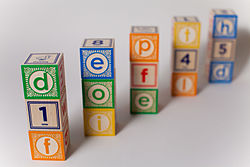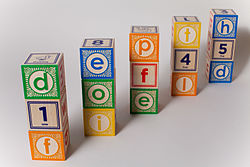Relationship of DOF to format size
In optics, particularly as it relates to film and photography, depth of field (DOF), also called focus range or effective focus range, is the distance between the nearest and farthest objects in a scene that appear acceptably sharp in an image. Although a lens can precisely focus at only one distance at a time, the decrease in sharpness is gradual on each side of the focused distance, so that within the DOF, the unsharpness is imperceptible under normal viewing conditions.
In some cases, it may be desirable to have the entire image sharp, and a large DOF is appropriate. In other cases, a small DOF may be more effective, emphasizing the subject while de-emphasizing the foreground and background. In cinematography, a large DOF is often called deep focus, and a small DOF is often called shallow focus.
A macro photograph with very shallow depth of field
Digital techniques, such as ray tracing, can also render 3D models with shallow depth of field for the same effect.
Simulation of the effect of changing a camera's aperture in half-stops (at left) and from zero to infinity (at right)
Circle of confusion criterion for depth of field
Factors affecting depth of fieldEdit
A 35 mm lens set to f/11. The depth-of-field scale (top) indicates that a subject which is anywhere between 1 and 2 meters in front of the camera will be rendered acceptably sharp. If the aperture were set to f/22 instead, everything from just over 0.7 meters almost to infinity would appear to be in focus.
Out-of-focus highlights have the shape of the lens aperture.
Several other factors, such as subject matter, movement, camera-to-subject distance, lens focal length, selected lens f-number, format size, and circle of confusion criteria also influence when a given defocus becomes noticeable. The combination of focal length, subject distance, and format size defines magnification at the film / sensor plane.
DOF is determined by subject magnification at the film / sensor plane and the selected lens aperture or f-number. For a given f-number, increasing the magnification, either by moving closer to the subject or using a lens of greater focal length, decreases the DOF; decreasing magnification increases DOF. For a given subject magnification, increasing the f-number (decreasing the aperture diameter) increases the DOF; decreasing f-number decreases DOF.
If the original image is enlarged to make the final image, the circle of confusion in the original image must be smaller than that in the final image by the ratio of enlargement. Cropping an image and enlarging to the same size final image as an uncropped image taken under the same conditions is equivalent to using a smaller format under the same conditions, so the cropped image has less DOF. (Stroebel 1976, 134, 136–37).
When focus is set to the hyperfocal distance, the DOF extends from half the hyperfocal distance to infinity, and the DOF is the largest possible for a given f-number.
Relationship of DOF to format sizeEdit
The comparative DOFs of two different format sizes depend on the conditions of the comparison. The DOF for the smaller format can be either more than or less than that for the larger format. In the discussion that follows, it is assumed that the final images from both formats are the same size, are viewed from the same distance, and are judged with the same circle of confusion criterion. (Derivations of the effects of format size are given under Derivation of the DOF formulae.)
"Same picture" for both formats
When the "same picture" is taken in two different format sizes from the same distance at the same f-number with lenses that give the same angle of view, and the final images (e.g., in prints, or on a projection screen or electronic display) are the same size, DOF is, to a first approximation, inversely proportional to format size (Stroebel 1976, 139). Though commonly used when comparing formats, the approximation is valid only when the subject distance is large in comparison with the focal length of the larger format and small in comparison with the hyperfocal distance of the smaller format.
Moreover, the larger the format size, the longer a lens will need to be to capture the same framing as a smaller format. In motion pictures, for example, a frame with a 12 degree horizontal field of view will require a 50 mm lens on 16 mm film, a 100 mm lens on 35 mm film, and a 250 mm lens on 65 mm film. Conversely, using the same focal length lens with each of these formats will yield a progressively wider image as the film format gets larger: a 50 mm lens has a horizontal field of view of 12 degrees on 16 mm film, 23.6 degrees on 35 mm film, and 55.6 degrees on 65 mm film. Therefore, because the larger formats require longer lenses than the smaller ones, they will accordingly have a smaller depth of field. Compensations in exposure, framing, or subject distance need to be made in order to make one format look like it was filmed in another format.
Same focal length for both formatsEdit
Many small-format digital SLR camera systems allow using many of the same lenses on both full-frame and "cropped format" cameras. If, for the same focal length setting, the subject distance is adjusted to provide the same field of view at the subject, at the same f-number and final-image size, the smaller format has greater DOF, as with the "same picture" comparison above. If pictures are taken from the same distance using the same f-number, same focal length, and the final images are the same size, the smaller format has less DOF. If pictures taken from the same subject distance using the same focal length, are given the same enlargement, both final images will have the same DOF. The pictures from the two formats will differ because of the different angles of view. If the larger format is cropped to the captured area of the smaller format, the final images will have the same angle of view, have been given the same enlargement, and have the same DOF.
Same DOF for both formatsEdit
In many cases, the DOF is fixed by the requirements of the desired image. For a given DOF and field of view, the required f-number is proportional to the format size. For example, if a 35 mm camera required f/11, a 4×5 camera would require f/45 to give the same DOF. For the same ISO speed, the exposure time on the 4×5 would be sixteen times as long; if the 35 camera required 1/250 second, the 4×5 camera would require 1/15 second. The longer exposure time with the larger camera might result in motion blur, especially with windy conditions, a moving subject, or an unsteady camera.
Adjusting the f-number to the camera format is equivalent to maintaining the same absolute aperture diameter; when set to the same absolute aperture diameters, both formats have the same DOF.
Comparison of fast standard lenses in the four main formats when used for portraiture with appropriate circles of confusion to produce an uncropped image at 10x8 inches to be viewed at 25 cm show that the following settings with similar aperture diameters produce similar DoF:
67 medium format using a 90 mm lens set to f/2.8 (32 mm aperture) gives a hyperfocal distance (H) of 49m. If focussed on a subject at 2m (s) the depth of field ranges from Dn=1.921m to Df = 2.085m (DoF = 163mm).35mm (FX) 50 mm lens set to f/2 (25 mm aperture) gives H = 43m. If focussed to 2m the DoF is 1.911 to 2.097m (186mm).APSc (DX) 35 mm lens set to f/1.4 (25 mm aperture) gives H = 46m. If focussed to 2m the DoF is 1.917 to 2.091m (174mm).Four thirds 25 mm lens set to f/0.95 (26 mm aperture) gives H = 44m. If focussed to 2m the DoF is 1.913 to 2.095m (183mm).
For any of these, doubling the f-number will approximately double the depth of field.
Camera movements and DOFEdit
Scheimpflug principle.
When the lens axis is perpendicular to the image plane, as is normally the case, the plane of focus (POF) is parallel to the image plane, and the DOF extends between parallel planes on either side of the POF. When the lens axis is not perpendicular to the image plane, the POF is no longer parallel to the image plane; the ability to rotate the POF is known as the Scheimpflug principle. Rotation of the POF is accomplished with camera movements (tilt, a rotation of the lens about a horizontal axis, or swing, a rotation about a vertical axis). Tilt and swing are available on most view cameras, and are also available with specific lenses on some small- and medium-format cameras.
When the POF is rotated, the near and far limits of DOF are no longer parallel; the DOF becomes wedge-shaped, with the apex of the wedge nearest the camera (Merklinger 1993, 31–32; Tillmanns 1997, 71). With tilt, the height of the DOF increases with distance from the camera; with swing, the width of the DOF increases with distance.
In some cases, rotating the POF can better fit the DOF to the scene, and achieve the required sharpness at a smaller f-number. Alternatively, rotating the POF, in combination with a small f-number, can minimize the part of an image that is within the DOF.
Effect of lens apertureEdit
Effect of aperture on blur and DOF. The points in focus (2) project points onto the image plane (5), but points at different distances (1 and 3) project blurred images, or circles of confusion. Decreasing the aperture size (4) reduces the size of the blur spots for points not in the focused plane, so that the blurring is imperceptible, and all points are within the DOF.
For a given subject framing and camera position, the DOF is controlled by the lens aperture diameter, which is usually specified as the f-number, the ratio of lens focal length to aperture diameter. Reducing the aperture diameter (increasing the f-number) increases the DOF because the circle of confusion is shrunk directly and indirectly by reducing the light hitting the outside of the lens which is focused to a different point than light hitting the inside of the lens due to spherical aberration caused by the construction of the lens;[7] however, it also reduces the amount of light transmitted, and increases diffraction, placing a practical limit on the extent to which DOF can be increased by reducing the aperture diameter.
Motion pictures make only limited use of this control; to produce a consistent image quality from shot to shot, cinematographers usually choose a single aperture setting for interiors and another for exteriors, and adjust exposure through the use of camera filters or light levels. Aperture settings are adjusted more frequently in still photography, where variations in depth of field are used to produce a variety of special effects.
Aperture = f/1.4. DOF=0.8 cm
Aperture = f/4.0. DOF=2.2 cm
Aperture = f/22. DOF=12.4 cm
Depth of field for different values of aperture using 50 mm objective lens and full-frame DSLR camera. Focus point is on the first blocks column.[8]
Digital techniques affecting DOFEdit
Series of images demonstrating a 6 image focus bracket of a Tachinid fly. First two images illustrate typical DOF of a single image at f/10 while the third image is the composite of 6 images.
The advent of digital technology in photography has provided additional means of controlling the extent of image sharpness; some methods allow extended DOF that would be impossible with traditional techniques, and some allow the DOF to be determined after the image is made.
Focus stacking is a digital image processing technique which combines multiple images taken at different focus distances to give a resulting image with a greater depth of field than any of the individual source images. Available programs for multi-shot DOF enhancement include Adobe Photoshop, Syncroscopy AutoMontage, PhotoAcute Studio, Helicon Focus and CombineZ. Getting sufficient depth of field can be particularly challenging in macro photography. The images to the right illustrate the extended DOF that can be achieved by combining multiple images.
Wavefront coding is a method that convolves rays in such a way that it provides an image where fields are in focus simultaneously with all planes out of focus by a constant amount.
A plenoptic camera uses a microlens array to capture 4D light field information about a scene.
Colour apodization is a technique combining a modified lens design with image processing to achieve an increased depth of field. The lens is modified such that each colour channel has a different lens aperture. For example, the red channel may be f/2.4, green may be f/2.4, whilst the blue channel may be f/5.6. Therefore, the blue channel will have a greater depth of field than the other colours. The image processing identifies blurred regions in the red and green channels and in these regions copies the sharper edge data from the blue channel. The result is an image that combines the best features from the different f-numbers, (Kay 2011).
In 2013, Nokia implemented DOF control in some of its high-end smartphones, called Refocus, which can change a picture's depth of field after the picture is taken. It works best when there are close-up and distant objects in the frame.[9]
Diffraction and DOFEdit
See also: Rayleigh length
If the camera position and image framing (i.e., angle of view) have been chosen, the only means of controlling DOF is the lens aperture. Most DOF formulas imply that any arbitrary DOF can be achieved by using a sufficiently large f-number. Because of diffraction, however, this isn't really true. Once a lens is stopped down to where most aberrations are well corrected, stopping down further will decrease sharpness in the plane of focus. At the DOF limits, however, further stopping down decreases the size of the defocus blur spot, and the overall sharpness may still increase. Eventually, the defocus blur spot becomes negligibly small, and further stopping down serves only to decrease sharpness even at DOF limits (Gibson 1975, 64). There is thus a tradeoff between sharpness in the POF and sharpness at the DOF limits. But the sharpness in the POF is always greater than that at the DOF limits; if the blur at the DOF limits is imperceptible, the blur in the POF is imperceptible as well.
For general photography, diffraction at DOF limits typically becomes significant only at fairly large f-numbers; because large f-numbers typically require long exposure times, motion blur may cause greater loss of sharpness than the loss from diffraction. The size of the diffraction blur spot depends on the effective f-number {\displaystyle N\left(1+m\right)}













Nhận xét
Đăng nhận xét